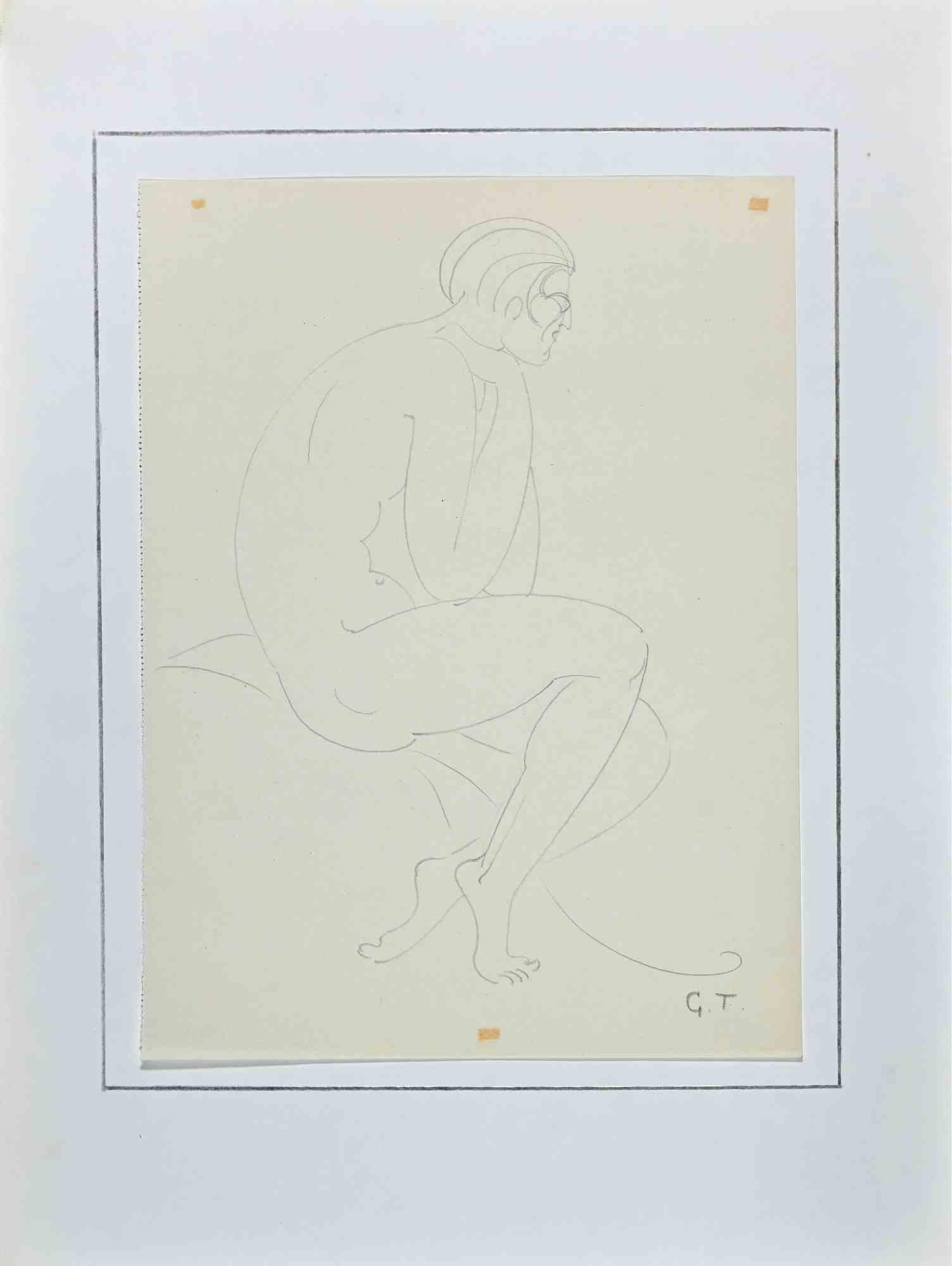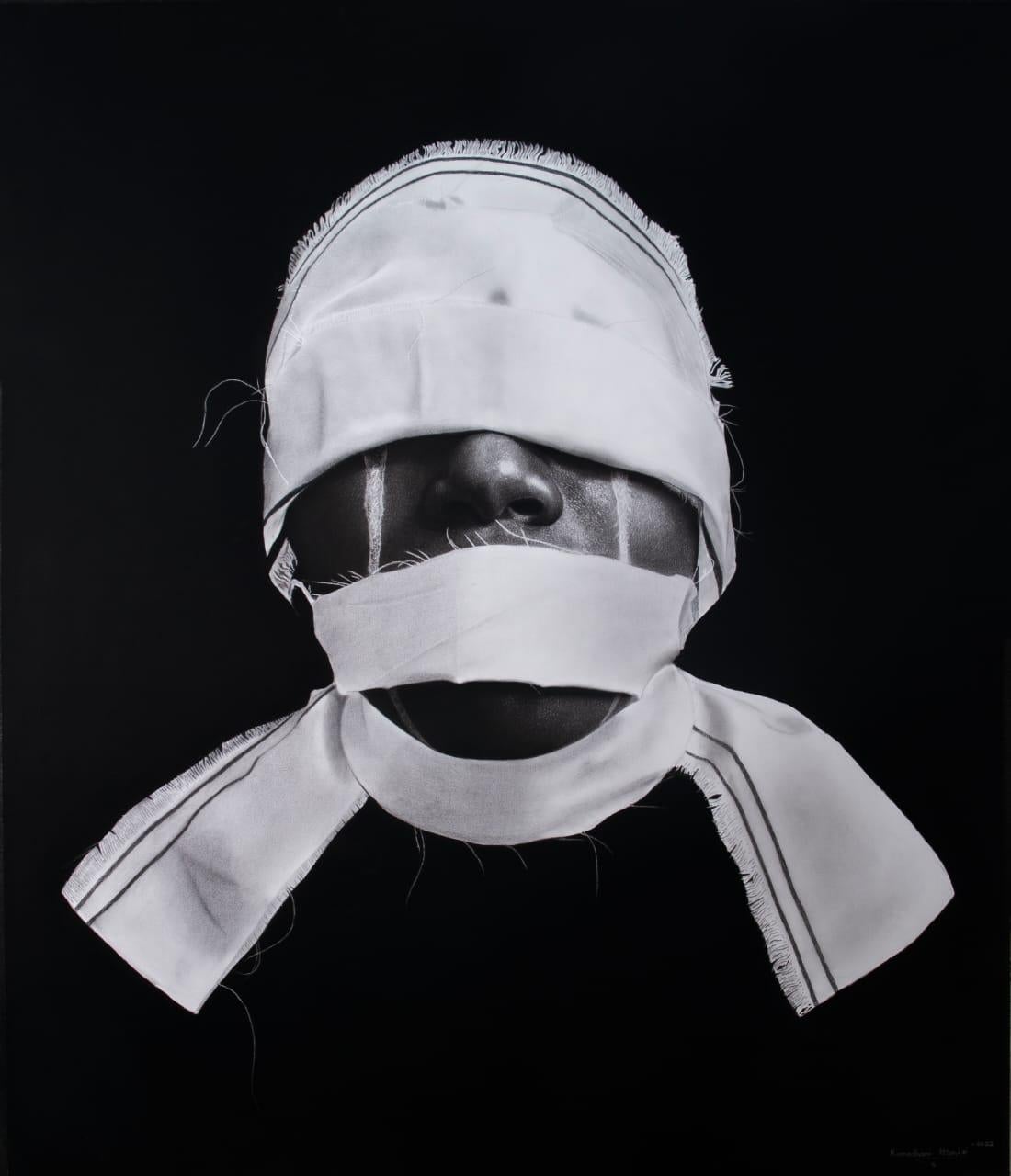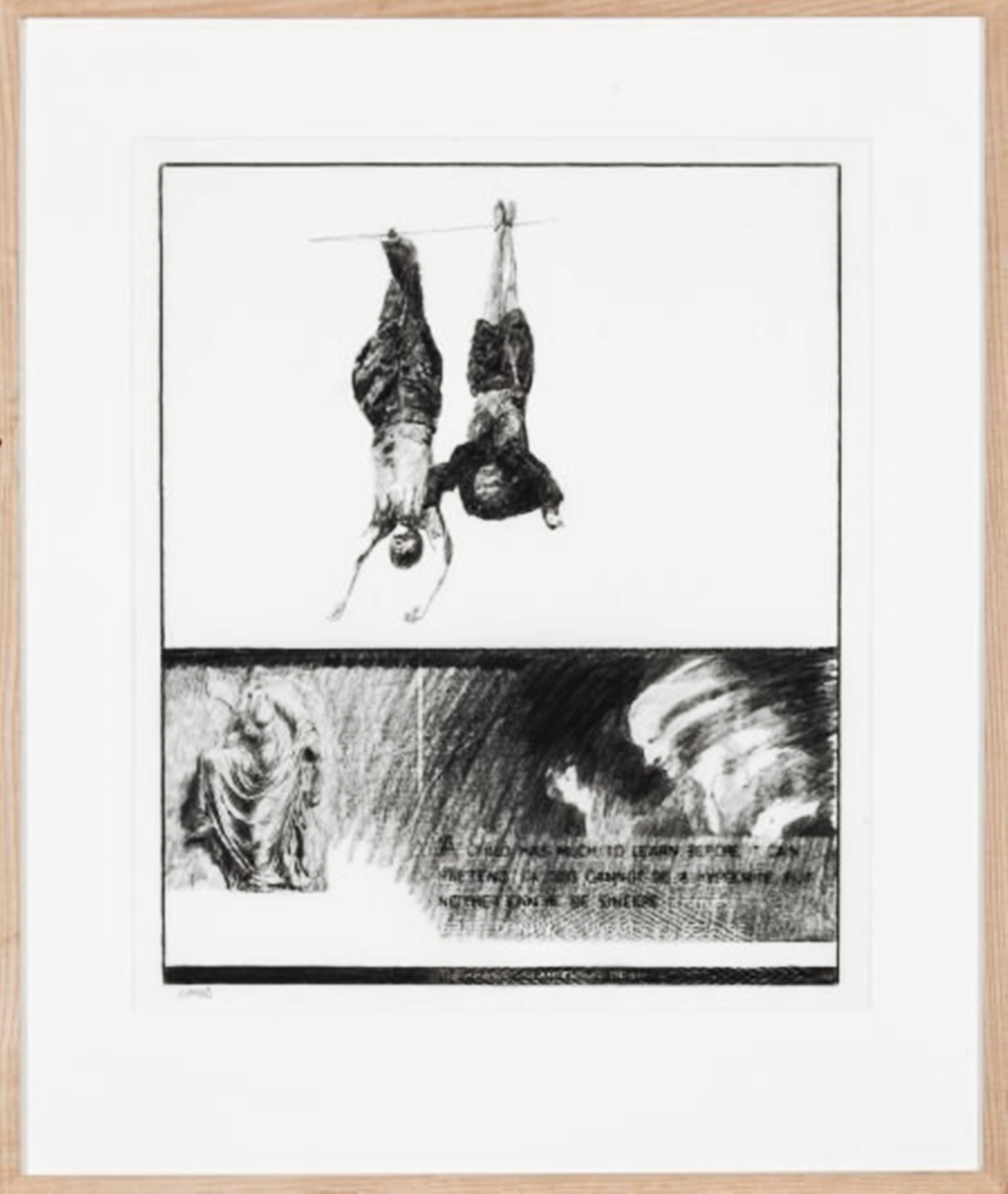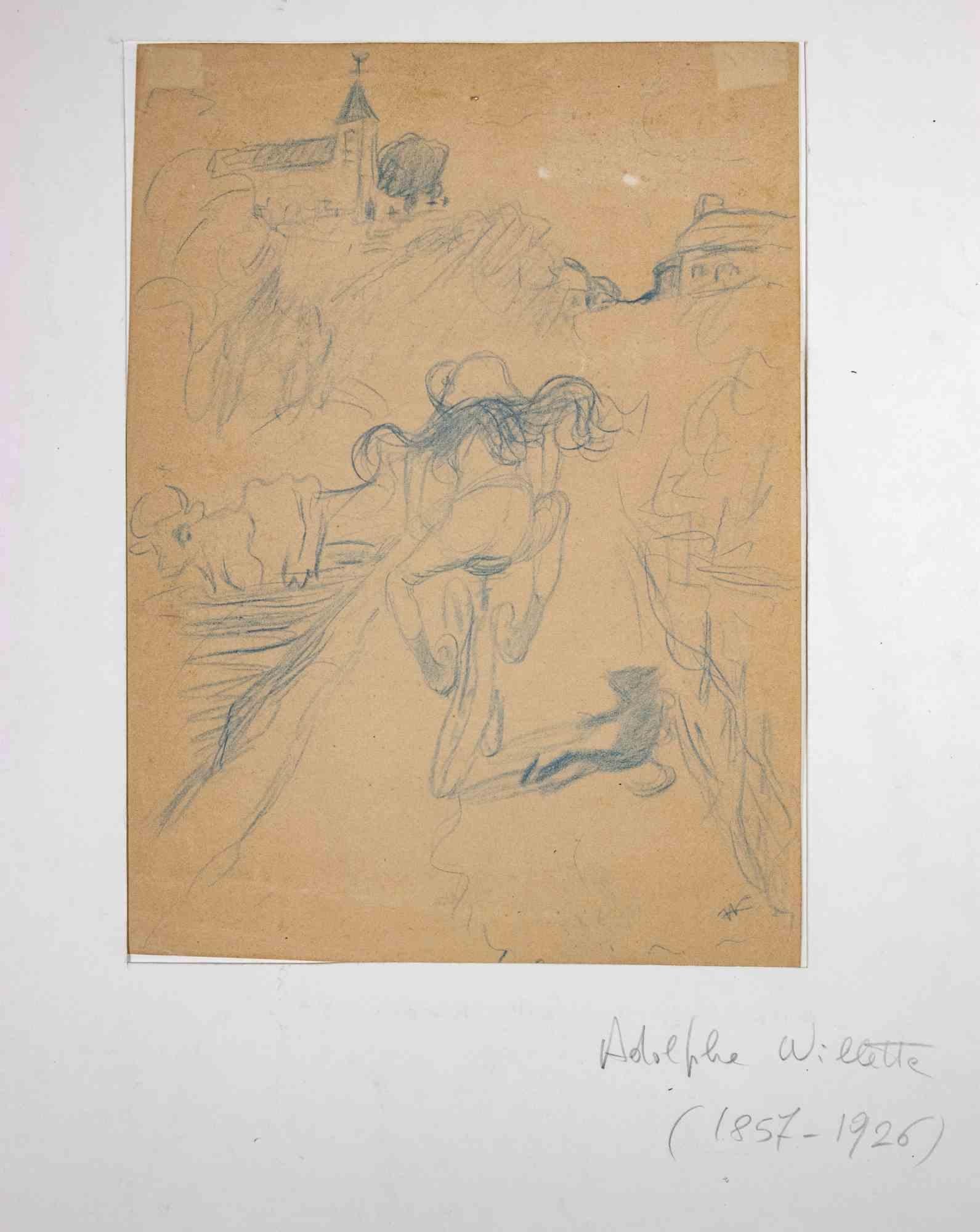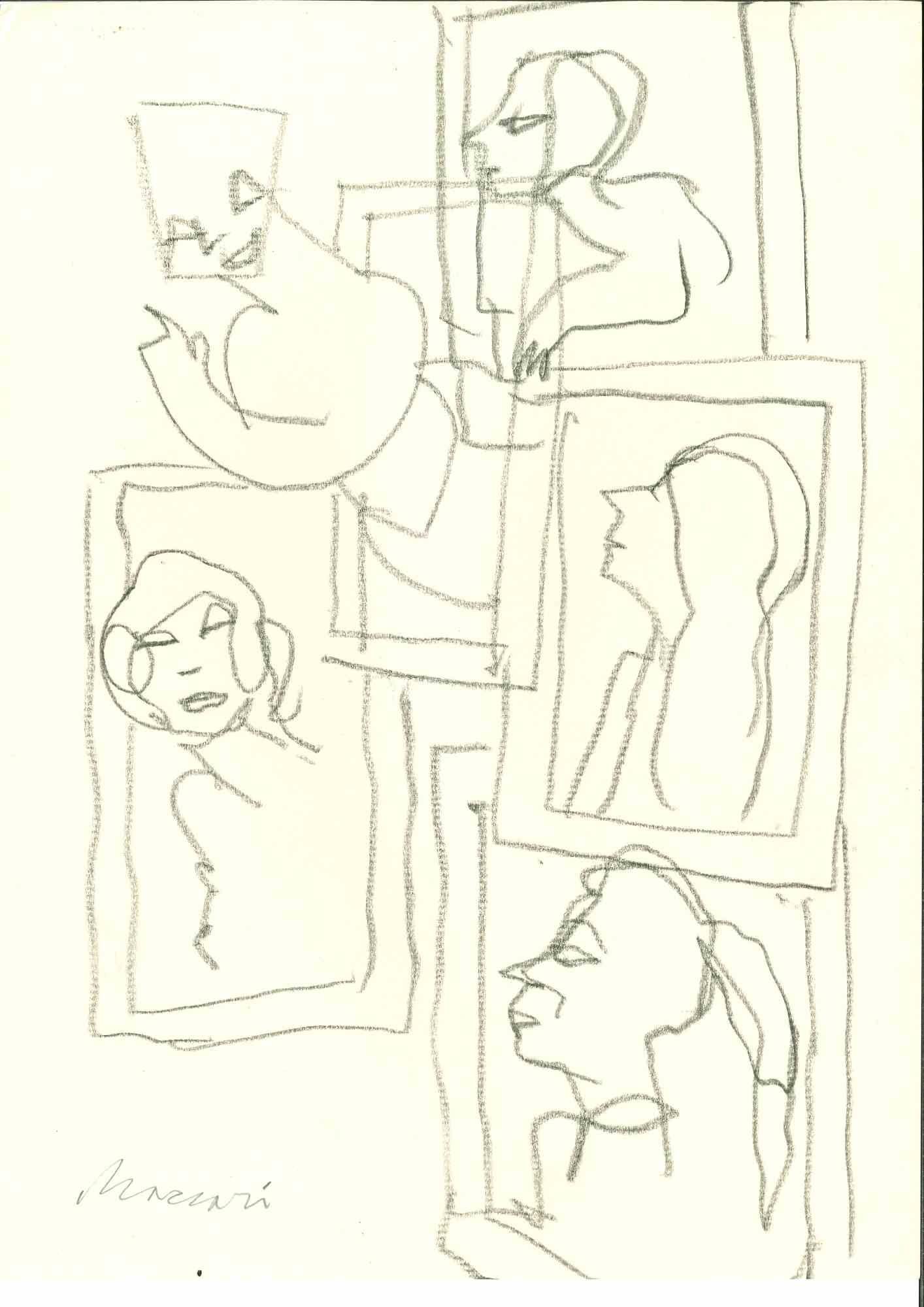Items Similar to 20th century British Drawing - Les Deux Landaises (Evening)
Want more images or videos?
Request additional images or videos from the seller
1 of 8
Gerald Leslie Brockhurst20th century British Drawing - Les Deux Landaises (Evening)circa 1920
circa 1920
About the Item
Pencil on paper
Signed 'G.L. Brockhurst’ (lower right)
Drawn c.1920
Collections:
The Fine Art Society, London, 1981;
Mr & Mrs Alan Fortunoff, acquired from the above;
Private collection to 2019
Literature:
Stephen Wildman (et al), A Dream of Fair Women: An Exhibition of the Work of Gerald Leslie Brockhurst, R.A. (1890-1978): Painter and Etcher, exhibition catalogue, 1986, no. 49.
Exhibition:
London, The Fine Art Society, 1981;
Sheffield, Graves Art Gallery, Birmingham, City Art Gallery and London, National Portrait Gallery, A Dream of Fair Women: An Exhibition of the Work of Gerald Leslie Brockhurst, R.A. (1890-1978): Painter and Etcher, 1986-87 1987, no. 49;
London, The Fine Art Society, Gerard Leslie Brockhurst, 2011, no.12.
This spectacular drawing was made by Gerald Leslie Brockhurst in around 1920, it depicts his wife Anaïs seated whilst her sister, Marguerite Folin, stands dressing her hair; the drawing was turned into an etching by Brockhurst in 1923. Brockhurst variously called the print ‘Les Deux Landaises’, the two girls from Landes, a reference to the area of South-West France which was the native region of Anaïs and her sister and ‘Evening’. The tender and intimate drawing demonstrates Brockhurst’s virtuosic handling of graphite and his self-conscious interest in a long tradition of depicting women at their toilet. Rendered minutely in etching, the print points to Brockhurst’s specific interest in Rembrandt, recalling, as it does, The Great Jewish Bride.
Brockhurst was born in Birmingham where, in 1901, he was registered at the Birmingham School of Art. He won a place at the Royal Academy Schools in 1907. At the Academy, among other awards, he won the gold medal and travelling scholarship which enabled him to visit Paris and Italy where he became enthralled by the art of fifteenth-century Italian painters, specifically the work of Piero della Francesca. Their influence was to be central to the evolution of his own artistic development. On 5 December 1911, in Chelsea, he married his first wife, Anaïs Folin whose distinctive features provided the inspiration for many of his early portraits. During the 1920s Brockhurst established himself first as a printmaker of outstanding virtuosity and second as one of the most original and successful portrait painters of his generation. Brockhurst produced a sequence of eerily unsettling images of the greatest icons of the decade including the Duchess of Windsor, Merle Oberon and J. Paul Getty.
This intensely worked drawing of Anaïs and her sister was made in preparation for an etching published in 1923. Brockhurst’s sheet shows him carefully building up the composition, deliberately densely drawing areas such as Anaïs’s hair and the concentrated expression of her sister, leaving other areas, such as the table and contents of the room only lightly suggested. These decisions are reflected and developed in the finished etching where, for example, the blank table of the drawing is cast into gradated shadow in the finished print. Brockhurst’s feathery touch and minutely layered hatching point to the enduring impact of studying fifteenth-century Italian art, in the present sheet the graphite is handled with the dexterity of metal point. This drawing belonged to the most considerable collectors of Brockhurst’s works in the late twentieth century, Alan and Helene Fortunoff.
- Creator:Gerald Leslie Brockhurst (1890 - 1978, English)
- Creation Year:circa 1920
- Dimensions:Height: 14.25 in (36.2 cm)Width: 11.5 in (29.21 cm)
- Medium:
- Period:
- Condition:
- Gallery Location:London, GB
- Reference Number:1stDibs: LU150728412262
Gerald Leslie Brockhurst
(b Birmingham, 31 Oct. 1890; d Franklin Lakes, NJ, 4 May 1978). British-born painter and etcher who became an American citizen in 1949. Precociously gifted, an excellent draughtsman, and a fine craftsman, Brockhurst won several prizes at the Royal Academy Schools and went on to have a highly successful career as a society portraitist, first in Britain and then in the USA, where he settled in 1939, working in New York and New Jersey. He is best known for his portraits of glamorous women, painted in an eye-catching, dramatically lit, formally posed style similar to that later associated with Annigoni. As an etcher Brockhurst is remembered particularly for Adolescence (1932), a powerful study of a naked girl on the verge of womanhood staring broodingly into a mirror—one of the masterpieces of 20th-century printmaking.
About the Seller
5.0
Recognized Seller
These prestigious sellers are industry leaders and represent the highest echelon for item quality and design.
1stDibs seller since 2021
- ShippingRetrieving quote...Ships From: London, United Kingdom
- Return PolicyA return for this item may be initiated within 14 days of delivery.
More From This SellerView All
- 19th century watercolour of a Girl at her Dressing TableBy William Henry HuntLocated in London, GBCollections: Muir Hetherington; Sir John and Lady Witt, acquired 1974; By descent to 2015. Literature: Tom Jones (ed.), William Henry Hunt 1790-1864, exh. cat., 1981, no. 145 (Girl in a bedroom); John Witt, William Henry Hunt (1790-1864) Life and Work, London, 1982, no. 553, p. 194, colour pl. 16. Exhibited: Wolverhampton, Central Art Gallery, Preston, Harris Museum and Art Gallery and Hastings, Hastings Museum and Art Gallery, William Henry Hunt 1790-1864, 1981, no. 145 as Girl in a bedroom (Lent by Sir John & Lady Witt) Framed dimensions: 20 x 20.75 inches This unusually charming and well-preserved watercolour was painted by William Henry Hunt in around 1833. Almost certainly depicting his young wife, Sarah, possibly in the interior of her family home at Bramley in Hampshire. This work shows Hunt’s remarkable virtuosity as a watercolourist, Hunt, for example, articulates the profile of his young wife, by leaving a reserve of white paper to suggest the light modelling her features. Throughout the 1830s Hunt made a sequence of richly painted interior views of both domestic and agricultural spaces which pay scrupulous attention to detail. Hunt was born in London, the son of a tin-plate worker and japanner. J. L. Roget recorded the observation of Hunt’s uncle: ‘nervy, little Billy Hunt… was always a poor cripple, and as he was fit for nothing, they made an artist of him.’ At the age of sixteen he was apprenticed to the landscape painter John Varley for seven years, moving to live with Varley at 18 Broad Street, Golden Square, London. There he made close friends with both John Linnell and William Mulready. Hunt worked at the ‘Monro Academy’, at 8 Adelphi Terrace, London, the house of Dr Thomas Monro, an enthusiastic patron of landscape watercolourists. Through Monro, Hunt was introduced to the 5th Earl of Essex...Category
19th Century Old Masters Figurative Drawings and Watercolors
MaterialsPencil, Watercolor
- Eighteenth century Old Master drawing - St JeromeBy John Hamilton MortimerLocated in London, GBPen, ink and wash Framed dimensions: 9 ½ x 11 ¼ inches Drawn c. 1763 This small, powerful study shows St Jerome contemplating the bible with a cross and sk...Category
18th Century Old Masters Figurative Drawings and Watercolors
MaterialsPen, Ink
- Eighteenth century Old Master drawing - Apollo destroying Niobe's childrenBy John Hamilton MortimerLocated in London, GBPen, ink and wash Framed dimensions: 13 x 11 ¼ inches Drawn c.1765 Verso: a study of a hanged man Mortimer has filled this small sheet with action, depicting in the top right, Apollo and Artemis...Category
18th Century Old Masters Figurative Drawings and Watercolors
MaterialsPen, Ink
- Drawing of a captive womanBy Henry FuseliLocated in London, GBCollections: Sir Thomas Lawrence, who acquired the contents of Fuseli’s studio; Susan, Countess of Guilford, née Coutts (1771-1837), acquired from the Lawrence estate; Susan, Baroness North (1797-1884), daughter of the above; Mrs A. M. Jaffé, acquired in France, c. 1950 to 2016. Black chalks, on buff-coloured paper Stamped verso: ‘Baroness Norths Collection / of Drawings by H Fuseli Esq.’ Framed dimensions: 26.38 x 20.63 inches This boldly drawn sheet depicting a seated figure was made by Fuseli at an important and highly productive moment in his career. The monumental drawing is closely related to another sheet by Fuseli in the British Museum which Schiff published as subject unknown. Both drawings were made when Fuseli was designing his most important sequence of historical works, including scenes from Shakespeare and Milton, The Nightmare and The Death of Dido which was exhibited at the Royal Academy to great critical acclaim in 1781. The present drawing does not relate directly to any of Fuseli’s finished historical paintings of the period, but evidently the image of a slightly menacing, seated and covered old woman was precisely the sort of motif he was playing with. It is notable that the same figure reappears later in Fuseli’s work as the witch from Ben Jonson’s Witch’s Song which Fuseli produced as both a painting and engraving in 1812. Fuseli returned to London in 1779 from a highly creative and productive period in Rome and established himself as one of the leading history painters of the period. Fuseli re-established contact with his old mentor Sir Joshua Reynolds, becoming a regular guest at his dinner table and visitor to his studio. The earliest and most striking manifestation of this strategy was Fuseli's Death of Dido, exhibited in 1781 at the Royal Academy. Executed on the same scale as Reynolds's version (Royal Collection), Fuseli's vertically oriented picture was hung directly opposite Reynolds's with its horizontal orientation, inevitably inviting comparison between the two works and garnering Fuseli much publicity and favourable reviews in the newspapers. The present, previously unpublished sheet, relates closely to a drawing now in the British Museum. That sheet shows the same seated old woman, drawn on a smaller scale and more schematic in design, seated next to an anatomical drawing of a man. The pose of this figure is related to the pose of Dido in his Death of Dido; the foreshortened torso, arrangement of head, oblique view of Dido’s features and arms all suggest that the study can be viewed as an initial thought for the composition. Fuseli may have initially thought of including the figure of the hunched and covered old woman. Drawn on identical paper to the British Museum sheet, our study is an enlarged depiction of the same figure, more elaborately delineated and developed. The presence of a chain to the right of the figure, suggests that the iconography was related in some way to a scene of imprisonment. Fuseli had first explored the motif of the hooded old woman in an early Roman drawing, 'The Venus Seller'. The idea of a grotesque old woman, hooded and with angular nose and projecting chin seen in profile was most spectacularly used by Fuseli in his sequence of paintings depicting The Three Witches from Macbeth. Fuseli seems to have kept the present sheet and may have returned to it when preparing a painting of The Witch and the Mandrake from Ben Jonson’s Witch’s Song from his Masque of Queens in 1812. Here the same seated figure looks out from under her hood and picks a mandrake by moonlight. Jonson’s drama had been performed at the court of James I in 1609, inspired the subject. To throw the nobility of the queens into relief, the poet added a coven of witches, one of whom declares: ‘I last night lay all alone, On the ground, to hear the mandrake groan; And plucked him up, though he grew full low, And, as I had done, the cock did crow.’ The figure was reversed in the associated etching which was published in 1812. It seems likely that the present drawing remained as part of Fuseli’s working archive of figure studies. The present drawing was presumably purchased with the bulk of Fuseli’s drawings after the artist’s death by Sir Thomas Lawrence. Lawrence’s large group of Fuseli drawings were then acquired by Susan, Countess of Guildford (1771-1837). Lady Guildford was the eldest daughter of the banker Thomas Coutts (1735-1822), who himself had supported Fuseli’s journey to Rome in the 1770s and had remained one of the artist’s key...Category
18th Century Old Masters Figurative Drawings and Watercolors
MaterialsChalk
- 18th century portrait drawing of the Rev. William AtkinsonBy George RomneyLocated in London, GBCollections: Henry Scipio Reitlinger (1882-1950); Private collection, UK to 2019 Framed dimensions: 14.50 x 15.38 inches This drawing is one of only two known portrait drawings by Romney (as opposed to preliminary studies for portraits) and is dated by Alex Kidson as being executed no later than 1769. It is likely that the present drawing was originally part of a sketchbook, now largely dismembered (Abbot Hall Art Gallery, Kendal), which Kidson notes, contained some of Romney’s most beautiful early drawings. This drawing, and a second sheet formerly with Andrew Wyld, have been identifying as depicting the Rev. William Atkinson...Category
18th Century Old Masters Portrait Drawings and Watercolors
MaterialsPencil
- Portrait drawing of Harriot Mellon, Mrs Thomas CouttsBy Henry FuseliLocated in London, GBInscribed by the artist in pen and brown ink, upper margin: 'σοφὴν δὲ μισῶ: μὴ γὰρ ἔν γ' ἐμοῖς δόμοις / εἴη φρονοῦσα πλείον' ἢ γυναῖκα χρή [Euripides, Hippolytus, 11, 640-41: “But a ...Category
19th Century Old Masters Portrait Drawings and Watercolors
MaterialsPencil
You May Also Like
- Blinded and Dumbed IILocated in Miami, FLRealism Portrait DrawingCategory
2010s Photorealist Portrait Drawings and Watercolors
MaterialsCharcoal, Archival Paper, Pencil
- Investigations (with Guggenheim Museum Exhibition Label)By Robert MorrisLocated in New York, NYRobert Morris Investigations (with Guggenheim Museum Labels), 1990 Graphite drawing on Mylar. Framed with the original Guggenheim Museum label (lent by Sonnabend), & Castelli Gallery...Category
1990s Minimalist Abstract Drawings and Watercolors
MaterialsMylar, Graphite
- Woman On Bicycle - Drawing by Adolphe Léon Willette - 1890sLocated in Roma, ITWoman On Bicycle is a Blue Pencil Drawing realized by Adolphe Léon Willette in 1890s. Good condition on a yellowed paper. Monogrammed, included a wh...Category
1890s Modern Figurative Drawings and Watercolors
MaterialsColor Pencil
- Women in Frames - Drawing by Mino Maccari - 1950sBy Mino MaccariLocated in Roma, ITWomen in Frames is a Pencil Drawing realized by Mino Maccari (1924-1989) in the 1960s. Hand-signed on the lower margin. Good conditions. Mino Maccari (Siena, 1924-Rome, June 16, ...Category
1950s Modern Figurative Drawings and Watercolors
MaterialsPencil
- Multiple Opportunities - Drawing by Mino Maccari - Mid-20th CenturyBy Mino MaccariLocated in Roma, ITMultiple Opportunities is a pencil Drawing realized by Mino Maccari (1924-1989) in the Mid-20th Century. Hand-signed on the lower. Good conditions. Mino Maccari (Siena, 1924-Rome...Category
Mid-20th Century Modern Figurative Drawings and Watercolors
MaterialsPencil
- Nude Man - Original Pencil Drawing by George-Henri Tribout - 1950sBy Georges-Henri TriboutLocated in Roma, ITNude Man is an original artwork realized by Georges Henri Tribout in about the 1950s. Pencil Drawing. Applied on a white Passepartout. Monogrammed on the lower " G.T" Good Conditio...Category
1950s Modern Figurative Drawings and Watercolors
MaterialsPencil
Recently Viewed
View AllMore Ways To Browse
20th Century British Art
British Prints And Drawings
British Seats
Early 20th Century British Paintings
British Gold Frames
Italian Painters Early 20th Century
Twentieth Century Drawings
1920s British
Italian School Pencil
British Medals
Mr Mrs Vintage
Evening Shadows
Evening Hair
Paul Gerard
Gerald French
French Vintage Dressing Table
Metal Windsor
Dressing Table Gray
